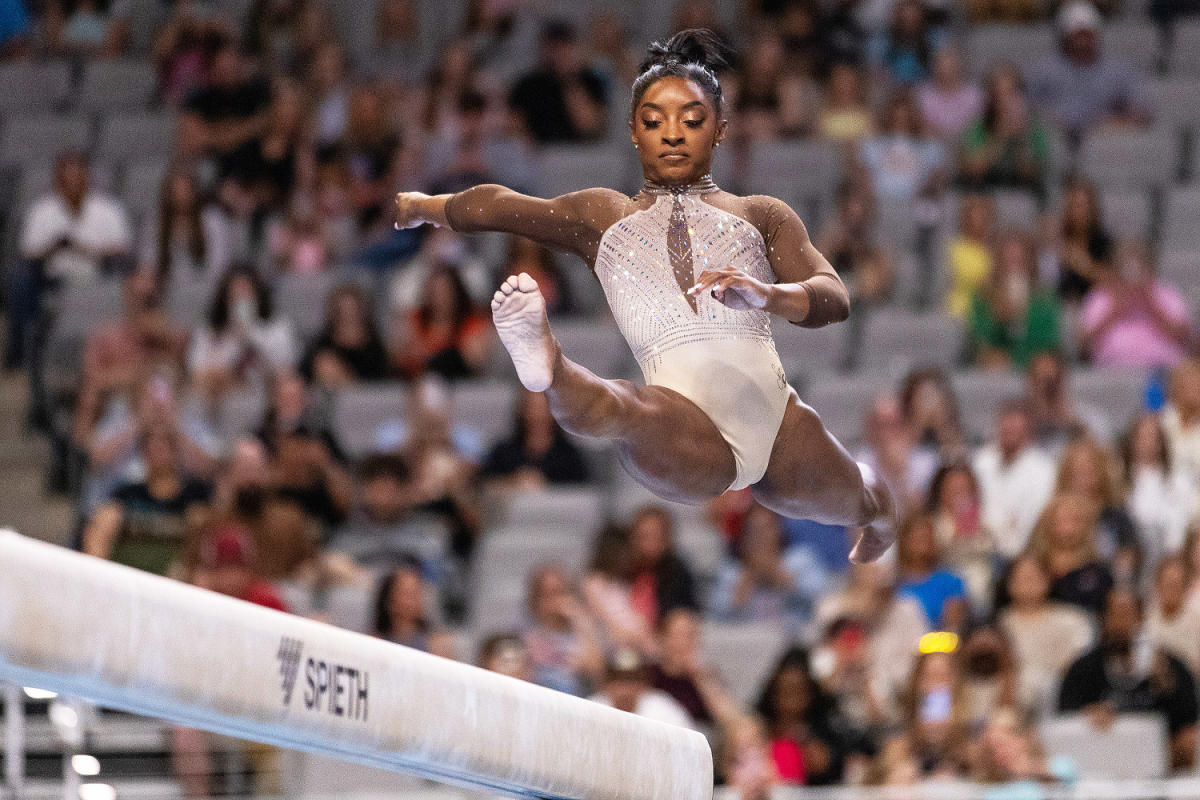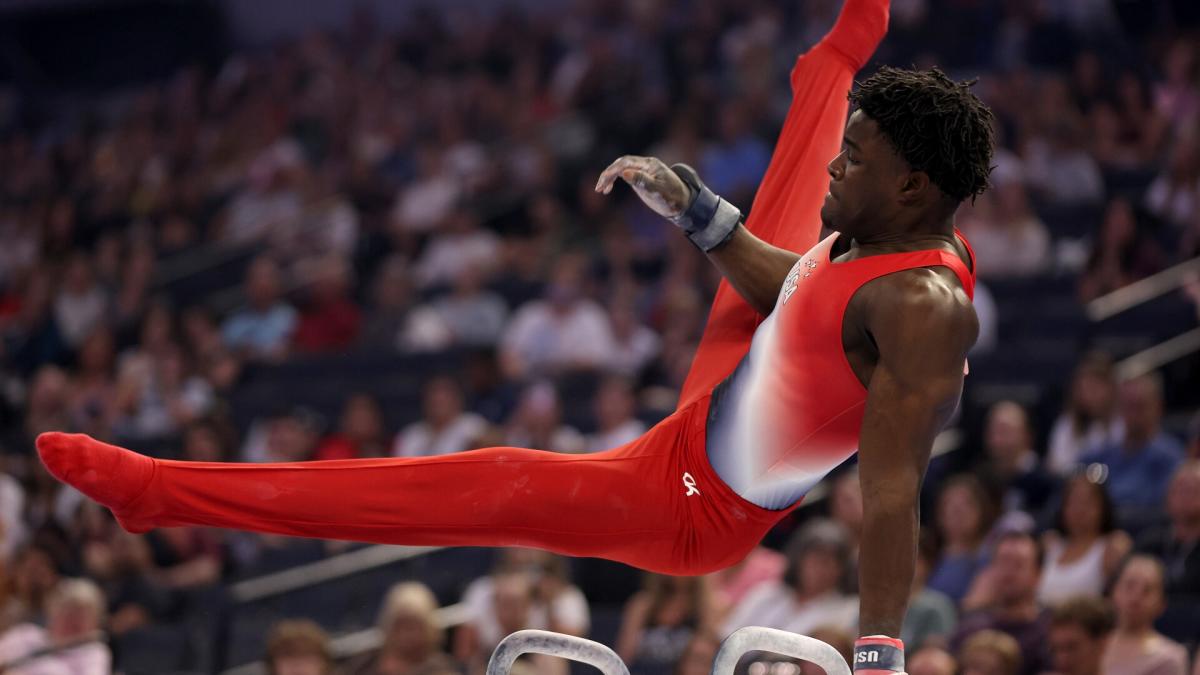Historical Overview of Women’s Gymnastics Olympic Trials
:max_bytes(150000):strip_icc():focal(749x176:751x178)/Olympic-Gymnastics-Team-Trials-062724-3-9ec0c1f8b62d4ec9a69db5b7becf318f.jpg)
The evolution of women’s gymnastics Olympic trials has been a testament to the growth and development of the sport. The trials have played a pivotal role in selecting the athletes who represent their countries at the Olympic Games, and the history of the trials is filled with memorable moments and milestones.
Women gymnastics olympic trials – The first women’s gymnastics Olympic trials were held in 1924 in Paris, France. The trials were a small affair, with only a handful of athletes competing. However, the trials quickly grew in popularity, and by the 1936 Olympic Games in Berlin, Germany, the trials were a major event. The trials have continued to grow in size and importance over the years, and they are now one of the most prestigious events in gymnastics.
Key Moments and Milestones
- The first women’s gymnastics Olympic trials were held in 1924 in Paris, France.
- The trials quickly grew in popularity, and by the 1936 Olympic Games in Berlin, Germany, the trials were a major event.
- The trials have continued to grow in size and importance over the years, and they are now one of the most prestigious events in gymnastics.
- In 1976, the trials were expanded to include two days of competition.
- In 1984, the trials were held in Indianapolis, Indiana, for the first time.
- In 1992, the trials were held in Baltimore, Maryland, for the first time.
- In 1996, the trials were held in Atlanta, Georgia, for the first time.
- In 2000, the trials were held in Philadelphia, Pennsylvania, for the first time.
- In 2004, the trials were held in Anaheim, California, for the first time.
- In 2008, the trials were held in Philadelphia, Pennsylvania, for the second time.
- In 2012, the trials were held in San Jose, California, for the first time.
- In 2016, the trials were held in Indianapolis, Indiana, for the second time.
- In 2020, the trials were held in St. Louis, Missouri, for the first time.
Rule Changes and Technological Advancements
The rules of the women’s gymnastics Olympic trials have changed over the years to reflect the changing nature of the sport. In the early days of the trials, athletes were required to compete in all four events (vault, uneven bars, balance beam, and floor exercise). However, in 1976, the rules were changed to allow athletes to specialize in two events. This change allowed athletes to focus on their strengths and improve their chances of making the Olympic team.
Women gymnastics olympic trials are underway, and the competition is fierce. Gymnasts from all over the country are vying for a spot on the Olympic team. The trials are being held in St. Louis, Missouri, and the top finishers will be announced on Sunday.
You can find more information about the olympic trials results on our website.
Technological advancements have also had a significant impact on the women’s gymnastics Olympic trials. In the early days of the trials, athletes were judged by a panel of judges who were seated at the side of the competition area. However, in 1984, the trials began using a computerized scoring system. This system allowed for more accurate and consistent scoring, and it has helped to improve the quality of competition at the trials.
The women’s gymnastics Olympic trials are a testament to the incredible athleticism and dedication of these young women. Among them, Kayla Dicello, a rising star in the sport, has captivated audiences with her grace and determination. Kayla Dicello is a true inspiration, showcasing the power of hard work and perseverance in the pursuit of excellence.
As the trials continue, we eagerly anticipate the remarkable performances that will ultimately shape the team that will represent our nation on the world stage.
The women’s gymnastics Olympic trials have come a long way since their humble beginnings in 1924. The trials are now a major event in gymnastics, and they play a vital role in selecting the athletes who represent their countries at the Olympic Games. The trials have been shaped by key moments and milestones, and they have been influenced by rule changes and technological advancements. As the sport of gymnastics continues to evolve, the trials will continue to play an important role in selecting the best athletes in the world.
Analysis of Top Performers and Contenders: Women Gymnastics Olympic Trials
The Olympic trials are the culmination of years of hard work and dedication for gymnasts across the country. Only the top gymnasts in the nation will qualify for the trials, and from there, only a select few will make the Olympic team. The competition is fierce, and the pressure is high, but the rewards are immeasurable.
This year’s Olympic trials field is one of the strongest in recent memory. Several gymnasts have already proven themselves to be world-class competitors, and many more are hoping to make a name for themselves on the biggest stage of all.
Top Performers
The top performers at the Olympic trials will be those who have consistently performed well throughout the season. These gymnasts will have high scores in all four events (vault, uneven bars, balance beam, and floor exercise), and they will be able to perform their routines with precision and consistency.
- Simone Biles: Biles is the reigning Olympic all-around champion and is considered to be the greatest gymnast of all time. She is a master of all four events and is known for her incredible strength, power, and flexibility.
- Sunisa Lee: Lee is the reigning Olympic all-around silver medalist and is one of the most promising young gymnasts in the world. She is known for her elegant style and her ability to perform difficult skills with ease.
- Jordan Chiles: Chiles is a two-time Olympian and is one of the most consistent gymnasts in the world. She is known for her strong all-around performance and her ability to hit her routines under pressure.
- Grace McCallum: McCallum is a rising star in the gymnastics world and is one of the top contenders for a spot on the Olympic team. She is known for her powerful tumbling and her ability to perform difficult skills with precision.
Contenders
In addition to the top performers, there are several other gymnasts who are considered to be contenders for a spot on the Olympic team. These gymnasts have all shown flashes of brilliance, and they will be looking to put together a strong performance at the trials to earn a spot on the team.
- Kayla DiCello: DiCello is a two-time NCAA champion and is one of the most experienced gymnasts in the field. She is known for her strong all-around performance and her ability to perform under pressure.
- Leanne Wong: Wong is a rising star in the gymnastics world and is one of the top contenders for a spot on the Olympic team. She is known for her powerful tumbling and her ability to perform difficult skills with ease.
- Jade Carey: Carey is a two-time world champion on the floor exercise and is one of the best tumblers in the world. She is hoping to make the Olympic team as a specialist on the floor exercise.
Medal Contenders
The medal contenders at the Olympics will be those gymnasts who have the ability to perform consistently at a high level. These gymnasts will need to be able to hit their routines under pressure and perform difficult skills with precision.
- Simone Biles: Biles is the clear favorite to win the gold medal in the all-around competition. She is the most dominant gymnast in the world and is capable of performing skills that no other gymnast can.
- Sunisa Lee: Lee is a strong contender for a medal in the all-around competition. She is a consistent performer and is capable of hitting difficult skills under pressure.
- Jordan Chiles: Chiles is a contender for a medal in the all-around competition and on the uneven bars. She is a strong all-around performer and is capable of hitting difficult skills under pressure.
- Grace McCallum: McCallum is a contender for a medal on the floor exercise. She is one of the best tumblers in the world and is capable of performing difficult skills with ease.
- Kayla DiCello: DiCello is a contender for a medal on the balance beam. She is a consistent performer and is capable of hitting difficult skills under pressure.
- Leanne Wong: Wong is a contender for a medal on the uneven bars and the floor exercise. She is a rising star in the gymnastics world and is capable of performing difficult skills with ease.
- Jade Carey: Carey is a contender for a medal on the floor exercise. She is a two-time world champion on the floor exercise and is one of the best tumblers in the world.
Impact of the Trials on the Olympic Team Selection
The U.S. Olympic Gymnastics Trials serve as a pivotal event in determining the composition of the Olympic gymnastics team. The trials results play a crucial role in selecting the six gymnasts who will represent the United States at the upcoming Olympic Games.
Factors Influencing Team Selection
The selection process for the Olympic gymnastics team is based on several key factors, including:
- Consistency: Gymnasts who demonstrate consistent performances across all four events (vault, uneven bars, balance beam, and floor exercise) are highly valued.
- Difficulty: Gymnasts who perform high-difficulty skills and routines earn higher scores and are more likely to be selected for the team.
- Execution: Gymnasts who execute their skills with precision and accuracy are more likely to impress the selection committee.
Potential Impact of Injuries or Setbacks, Women gymnastics olympic trials
Injuries or other setbacks can significantly impact team selection. If a top contender suffers an injury or is unable to compete at their full potential, it can open the door for other gymnasts to step up and earn a spot on the team.
The selection committee carefully considers the potential impact of injuries and setbacks when making their decisions. They may choose to select a gymnast with a slightly lower difficulty level but who has a proven track record of consistency and reliability over a gymnast with higher difficulty skills but who is more prone to errors or injuries.

